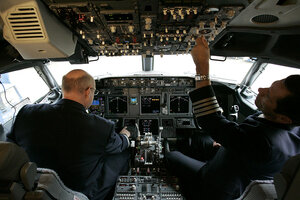Are commercial airliners too automated?
Too much dependence on automated systems can prompt pilots' thoughts veer to things unrelated to the flight, say researchers.

American Airlines Fleet Capt. Jim Kaiser, left, and Capt. Jim Thomas show the cockpit during a media preview of the newest addition to its fleet, Boeing 737-800 jets, Monday, April 13, 2009 at Dallas Fort Worth International Airport in Grapevine, Texas.
AP Photo/Donna McWilliam
What happens when machines replace humans in a cockpit?
New research published in the journal Human Factors examines pilots' response to automated systems within aircraft.
Researchers asked 18 pilots what they were thinking while they flew a Boeing 747-400 simulator. The pilots used two of the most commonly used levels of automation during the experiment – fully automated and partially automated levels. The former allows the flight management computer to decide where the airplane needs to go while the autopilot automatically steers the airplane.In partially automated levels the flight management computer decides where the airplane needs to go but the pilot actually steers the airplane manually, says Stephen Casner, coauthor of the paper and research psychologist at NASA's Ames Research Center.
Perhaps surprisingly, when the higher level of automation was used, the researchers did not see an increase in the number of task-unrelated thoughts. In fact, the researchers noticed an increase in the number of "big picture" task-related thoughts when using the higher level of automation. But when the flight was going smoothly and the automation did not require any further inputs from the pilots, their thoughts were more likely to wander. "This is where we would like to see the computers allow pilots to participate more in the flight," Dr. Casner wrote in an email.
"The automated systems in today's cockpits assume many of the tasks formerly performed by human pilots and do it with impressive reliability," Dr. Casner said in a press release. "This leaves pilots to watch over the automation as it does its work, but people can only concentrate on something uneventful for so long. Humans aren't robots. We can't stare at a green light for hours at a stretch without getting tired, bored, or going crazy."
In a way, we are underutilizing highly skilled labor by using a large number of automated systems, says Casner. "We have to ask ourselves if we have over automated them," he added.
Additionally, too much dependence on automation might pose challenges for pilots when it comes to handling unforeseen challenging events.
According to a report published by the Flight Deck Automation Working Group published last year, "[p]ilots sometimes rely too much on automated systems and may be reluctant to intervene." The report highlights the "vulnerabilities" in knowledge and skills of pilots in manual and automated flight mechanisms.
For pilots, sudden intervention can be difficult because they are not actively involved in controlling the flight from the very beginning. To figure out at a moment's notice what the automated systems are up to could be confusing, say researchers.
To ensure efficiency while keeping pilots actively engaged, the researchers recommend automation systems that "challeng[e] pilots with tasks that bring them back into the loop when things are under control and going well."

